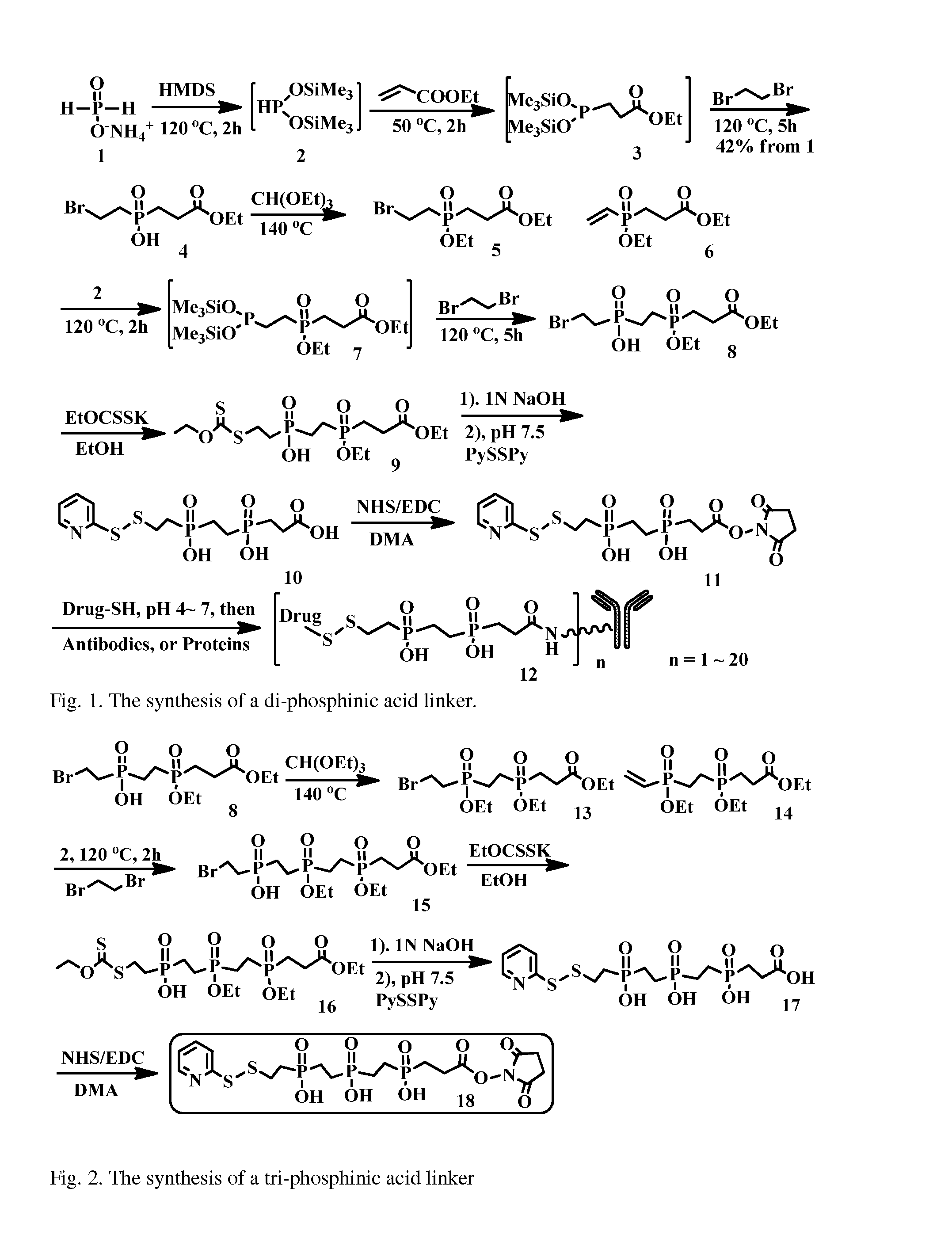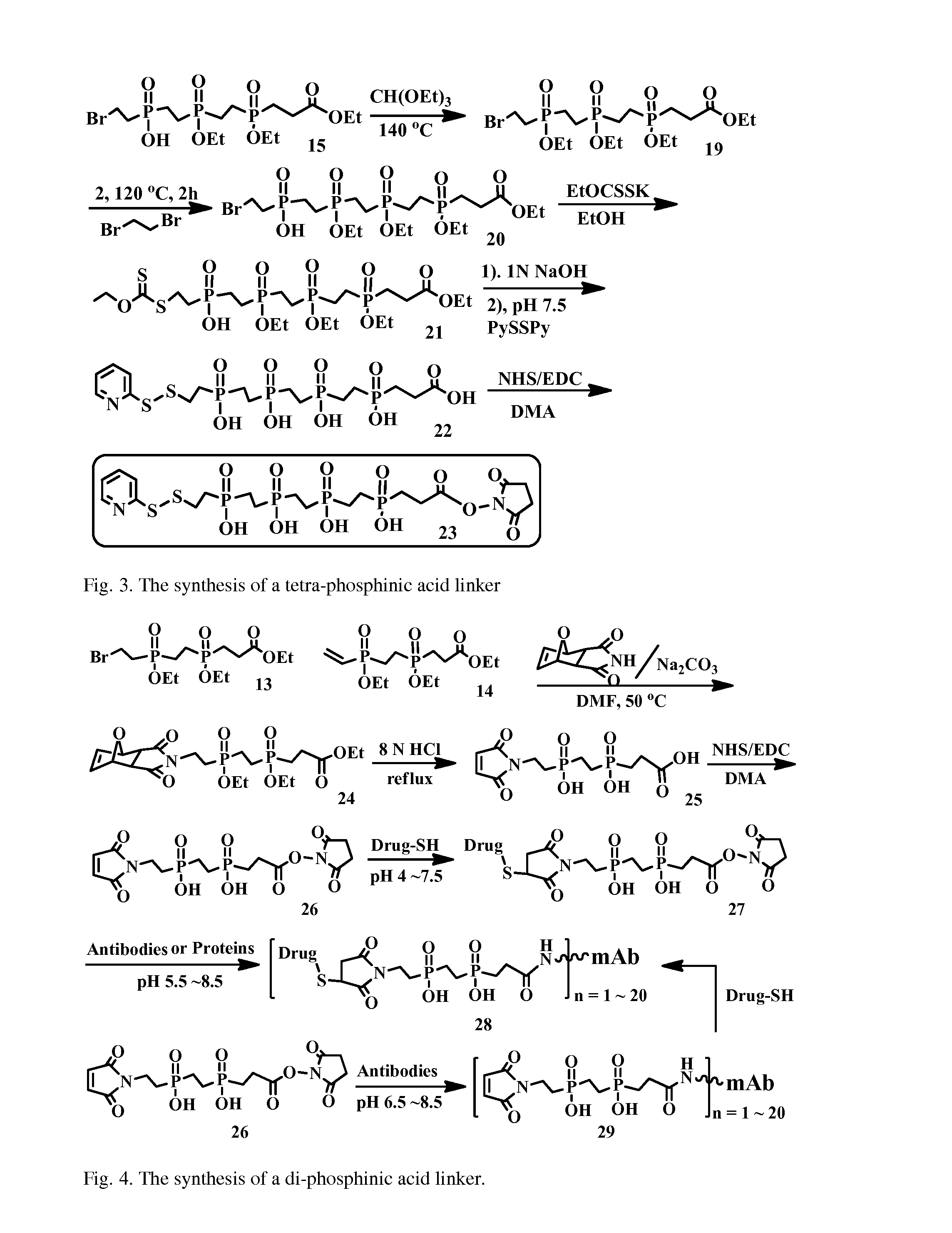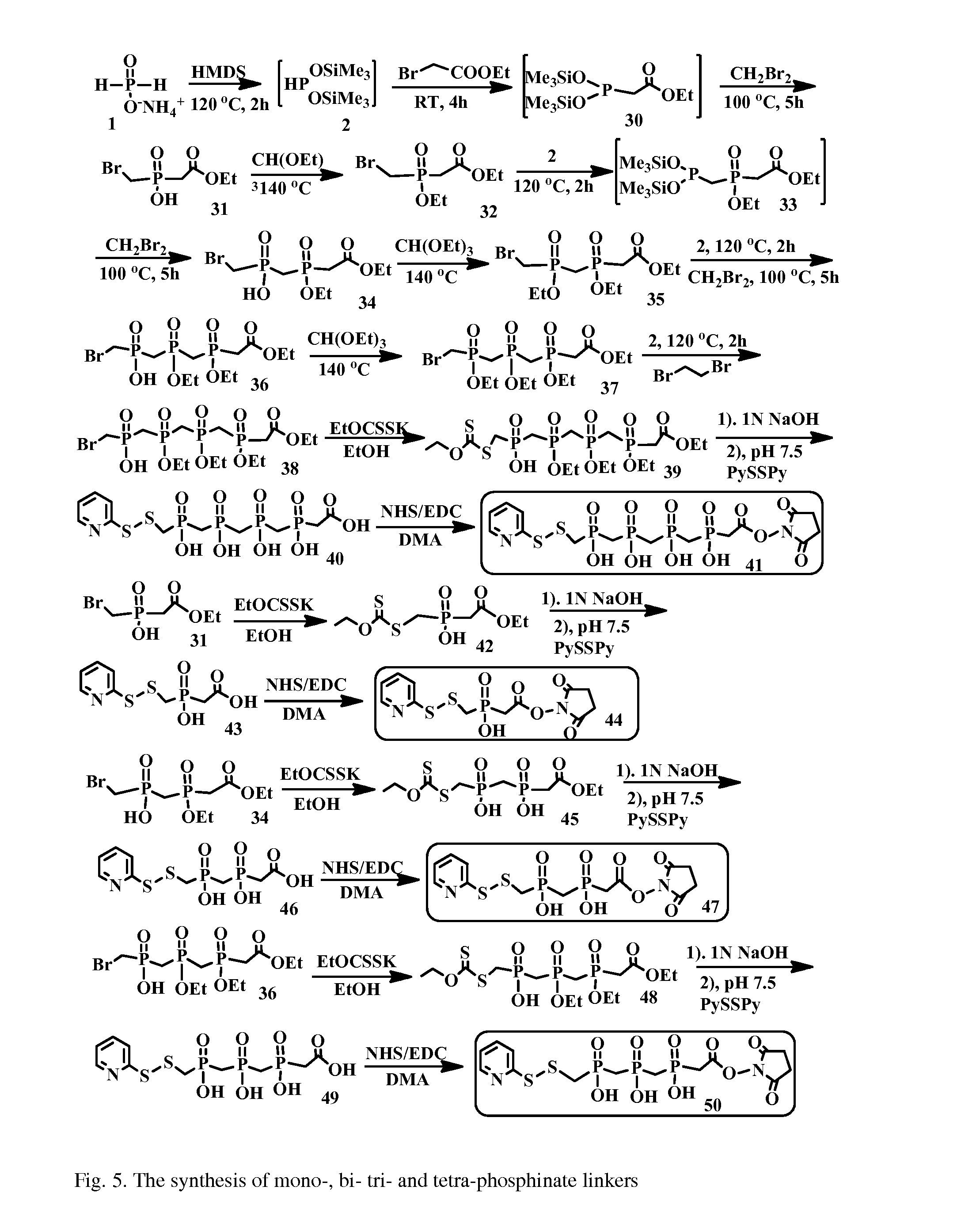Hydrophilic linkers and their uses for conjugation of drugs to a cell binding molecules
a cell binding molecule and hydrophilic linker technology, applied in the field of hydrophilic linkers, can solve the problems of cytotoxic drug conjugates aggregating, drug-per-cell binding molecule conjugates, antibody-drug conjugates, etc., and achieves the effects of reducing the aggregation of conjugates, and increasing the drug-per-cell binding molecule ratio
- Summary
- Abstract
- Description
- Claims
- Application Information
AI Technical Summary
Benefits of technology
Problems solved by technology
Method used
Image
Examples
example 1
(2-Bromoethyl)(3-ethoxy-3-oxopropyl)phosphinic acid (or ethyl 3-[2-Bromoethyl(hydroxy)phosphinyl]propanoate) (4)
[0141]
[0142]A mixture of ammonium hypophosphite (8.00 g, 96 mmol) and hexamethydisilazane (20.0 mL, 96 mmol) was heated at 120° C. for 1 h under argon. After the mixture was cooled to 0° C., ethyl acrylate (10.4 mL, 96 mmol) was carefully added dropwise, and the resulting mixture was stirred at 50° C. for 2 h. Then the mixture was cooled to room temperature, dibromoethane (40.0 mL) was added, and the mixture was stirred for 5 h at 120° C. The formed trimethylbromosilane and excess dibromoethane were removed under vacuum. Then 100 mL of aqueous ethanol (1:1) were added dropwise to the residue and refluxed for 0.5 h. Then the solvent was removed under vacuum and extracted with ethyl acetate. The organic layer was dried over magnesium sulfate and the solvent was removed under vacuum to give the title compound 4 (10.85 g, 41% yield). 1H NMR (300 MHz, CD3OD): δ 1.26 (t, J=7.1 H...
example 2
Ethyl 3-[2-Bromoethyl(ethoxy)phosphinyl]propanoate (5) and Ethyl 3-[Ethoxy(vinyl)phosphinyl]propanoate (6)
[0143]
[0144]An amount of 10.84 g of 4 (20 mmol) was treated with 100.0 mL of triethyl orthoformate, and the mixture was refluxed with a Dean-Stark trap to remove ethanol and ethyl formate. Excess triethyl orthoformate was removed under vacuum to give 5 and 6 ([39.2:60.8 31P NMR ratio], 11.83 g). 6: 1H NMR (300 MHz, CD3OD) δ 1.27 (m, 6H), 2.19 (m, 2H), 2.57 (m, 2H), 4.11 (m, 4H), 6.36 (m, 3H). 31P NMR (100 MHz, CD3OD): δ 44.9; 5: 31P NMR (100 MHz, CD3OD) δ 53.3; ESI MS m / z+, 5: 323.01 (M+Na), 6: 243.09 (M+Na).
example 3
(2-bromoethyl)(2-(ethoxy(3-ethoxy-3-oxopropyl)phosphoryl)ethyl)phosphinic acid (8)
[0145]
[0146]A mixture of ammonium hypophosphite (8.00 g, 96 mmol) and hexamethy-disilazane (20.0 mL, 96 mmol) was heated at 120° C. for 1 h under argon. After the mixture was cooled to 0° C., ethyl acrylate (10.4 mL, 96 mmol) was carefully added dropwise, and the resulting mixture was stirred at 50° C. for 2 h. Then the mixture of compound 5 and 6 (10.0 g, 38 4 mmol estimated from above ratio) was added and heated at 120° C. for 2 h under argon, followed by addition of 1,2-dibromoethane (40 ml) and the mixture was stirred for 5 h at 120° C. After the solvent was removed under vacuum, 100 mL of aqueous ethanol (1:1) were added dropwise to the residue and refluxed for 0.5 h. The mixture was concentrated and purified by SiO2 chromatographic column (1:20 to 1:10 MeOH / CH2Cl2) to afford the title compound 8 (6.48 g, 43%% yield). ESI MS m / z− 391.2 (M−H).
PUM
| Property | Measurement | Unit |
|---|---|---|
| Electric charge | aaaaa | aaaaa |
| Electrical conductance | aaaaa | aaaaa |
| Current | aaaaa | aaaaa |
Abstract
Description
Claims
Application Information
 Login to View More
Login to View More - R&D
- Intellectual Property
- Life Sciences
- Materials
- Tech Scout
- Unparalleled Data Quality
- Higher Quality Content
- 60% Fewer Hallucinations
Browse by: Latest US Patents, China's latest patents, Technical Efficacy Thesaurus, Application Domain, Technology Topic, Popular Technical Reports.
© 2025 PatSnap. All rights reserved.Legal|Privacy policy|Modern Slavery Act Transparency Statement|Sitemap|About US| Contact US: help@patsnap.com



